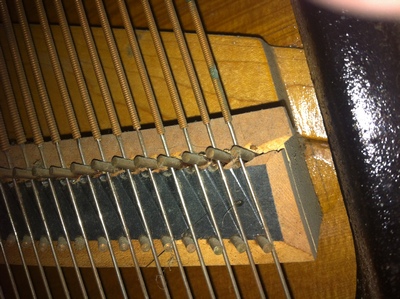Found these pictures on the net. Looks like there is some major work to be done. I thought I would include these for a laugh. The upper picture doesn’t look so hopeless. But the square grand!!

Here are some pictures of a set of very worn hammers and some new ones. The worn ones are very grooved and you can see a hammer where the wooden molding is showing through where the felt is completely gone. The new hammers show a nice rounded shape.
What sound do worn hammers make? When played loudly the flat surface of the hammer imparts a square shape into the string and brings out a lot of high harmonics which make for a bright or brittle sound. When played softly the grooves can actually make the hammer stick on the string for a short moment and make it dull sounding.
Hammers can be resurfaced by filing off layers of the felt to restore a smooth striking surface and a rounded shape. However the hammers in this picture would not improve a lot from filing them because there is so little felt left. These hammers need to be replaced.
Here we have an example of a split bass bridge. This will create a buzzing noise as the bridge pins rattle against the strings. The strings are supposed to be staggered as they go through the pins Notice the lines on the bridge that show where the strings used to be, and how the pins in the upper row have moved over to the right. To repair this requires making a new bridge cap.
When looking at a used piano, checking the state of the bridges is important. Repair of this is more expensive.

By making taking the stairs fun they changed peoples’ behavior
What do the pedals on a piano do?
Right pedal
The right pedal is the sustain pedal and holds notes that are played even after you let go of the key. This lets you connect notes and lets you play more notes than you could hold with your fingers.
Left pedal
The left pedal is the soft pedal. On a vertical piano, it moves the hammers closer to the string so the blow distance is less which lets you play more softly. On a grand piano, the left pedal shifts the whole keyboard and action to the hammers miss one of the strings. This makes the sound softer and changes the attack of the sound.
Middle pedal
The middle pedal on a large grand piano is the sustenuto pedal which holds any notes that are being played when the pedal is pressed and not others that are played afterwards. This can be used for organ music where a bass note is played and held with the sustenuto while other notes are played above it. On many vertical pianos, the middle pedal holds the notes in the bass section but not in the treble. This is a cheaper version of sustenuto. On the piano in the picture below the middle pedal activates a muffler rail which puts a strip of felt between the hammers and the strings. This makes the sound very soft so the piano can be played without bothering others. In this picture you can also see the dampers that sit against the strings to stop their sound. The damper lifts off the string when the key is played or the sustain pedal is pressed.
Adjusting pedals
On a vertical piano there is a bolt and nut that adjust the linkage between the pedal and the rod that activates the dampers. The pedal should have a small amount of “lost motion” so the dampers don’t start to move immediately. This lets you rest you foot gently on the pedal without raising the dampers.
Inside Indiana Business presented this information from Angie’s List:
Indianapolis-based Angie’s List Inc. (Nasdaq: ANGI) says for the seventh consecutive year, home warranty companies topped its list of the “Most Complained-About Companies.” Other “repeat offenders” include Internet service providers, property management companies and phone service providers. Consumers selected piano tuning for the least complained-about category.